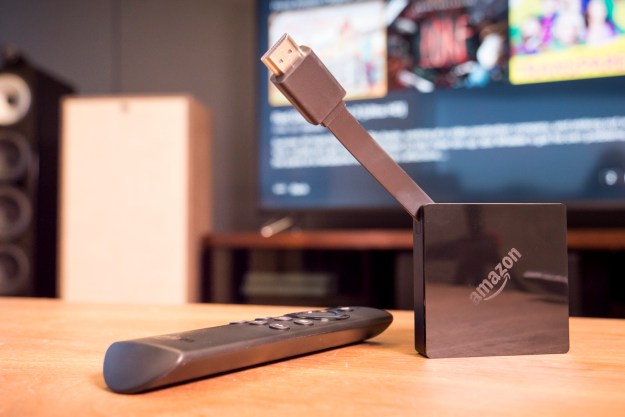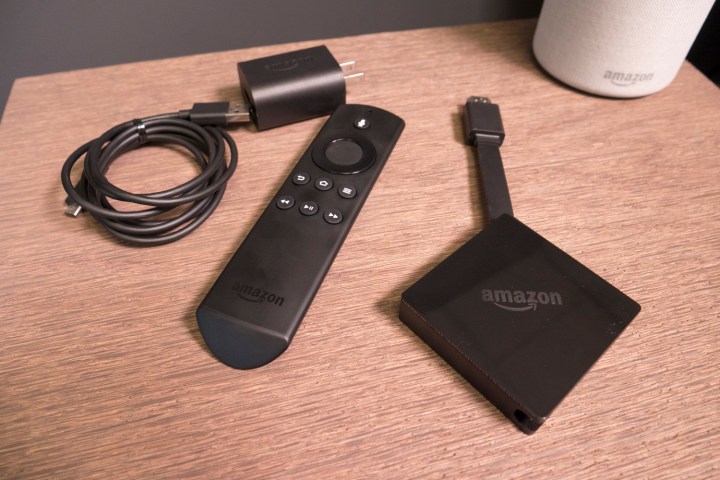
“Amazon’s new Fire TV is the most powerful streaming device you will find for the price.”
- Compact and portable
- Powerful
- Affordable
- Works with Alexa
- Supports HDR
- Dongle may strain HDMI ports
- No Ethernet jack
- No Dolby Vision
Frankly, we were a little surprised when Amazon announced its third-generation Fire TV. We were expecting perhaps a more powerful streaming stick, or maybe another svelte set-top box, but what we got instead was something in the middle: A sort of a turbocharged dongle like Google’s Chromecast Ultra, but with the on-screen user interface and handheld remote control we’ve become used to. Going into this Amazon Fire TV review, we wondered why the company went in this direction.
Amazon’s move might make sense, though. As streaming sticks have become increasingly powerful, the need for a set-top box has been relegated to power users who need a very specific set of connections and horsepower. Perhaps that audience has dwindled to the point that Amazon didn’t see the value in continuing to produce something very few people would buy. Is the Amazon Fire TV third-generation powerful enough to lay set-top boxes to rest? Let’s find out.
Out of the Box
Amazon’s product-packaging mojo is on point these days. The new Fire TV comes neatly arranged with its various components smartly tucked in recycled cardboard compartments. In a product category where simplicity is a cornerstone of design, Amazon’s approach excels.
In the box, you’ll find the new Amazon Fire TV dongle, a lengthy USB power cable, a wall adapter, an Alexa-enabled voice remote, a set of AAA batteries for said remote, and a basic setup guide. Priced at a reasonable $70, the kit can also be bundled with an Amazon Basics HD antenna for $75.
Setup
The new Amazon Fire TV improves on an already simple setup process by eliminating the need to find a place to stash a set-top box or run an HDMI cable. To install the new Amazon Fire TV, simply find a free HDMI port on the back of your TV (or soundbar, A/V receiver, etc.) and plug it right in.
In a product category where simplicity is a cornerstone of design, Amazon’s approach excels.
From there, you can either run the included USB power cable into an available USB slot on your TV, or plug into a wall outlet or power strip using the supplied wall adapter. We suggest putting the wall adapter in play, as using a TV’s USB port means the new Fire TV will power down with the TV, requiring extra time for it to boot up. Using a wall adapter means it will always be on and at the ready.
We are a little concerned about the weight of the new Amazon Fire TV, as it could put unwanted strain on both its HDMI connector and the HDMI jack in the TV. To reduce strain, we suggest affixing the dongle to the TV using removable adhesive strips or Velcro.
Once the device is plugged in and powered on, Amazon will run you through a brief setup wizard. You may need to connect the remote to the Fire TV by pressing and holding the home button for about 10 seconds. Once connected, you’ll enter your Wi-Fi router password, select from a handful of popular apps to be downloaded immediately, and sit through a tutorial video which can be skipped if you’re already familiar with how Fire TV works.
If you want to control your Fire TV device with an Alexa-enabled speaker like the new Amazon Echo or Sonos One, you’ll first need to link the devices together using the Amazon Alexa app, You’ll also need 2GB of RAM with 8GB of internal storage. These specs are better than an Amazon Fire TV stick, but not as powerful as the second-gen Fire TV box.
Gone for this iteration is an Ethernet port. We’re a little concerned about this omission considering Wi-Fi strength for the device is going to vary from user to user, and is potentially further hindered by a TV’s electronic interference. Considering 4K Ultra HD content depends on a solid internet connection and plenty of bandwidth, the lack of Ethernet connection could be a liability for some.
Just like the prior Fire TV box, this new dongle-style Fire TV lacks any kind of audio output jack. The good news for Dolby Atmos-enabled A/V receiver owners is that the dongle dishes up Dolby Atmos audio when available. The bad news for most TV owners is that Dolby Atmos is rarely passed out via HDMI ARC (new LG TVs are a notable exception), so if you want that sweet Dolby Atmos surround audio, consider connecting directly to your A/V receiver for best results.
The included remote control has a mic and mic button for using voice control and search with Amazon Alexa. This makes finding content much easier, and allows users to do all kinds of clever things with their Fire TV remote, such as dim smart lighting, close shades, and order pizza using the Domino’s Pizza Alexa skill.
Alexa can also launch Spotify playlists, Pandora channels, and other content. What Alexa can’t do is play a specific movie or TV show through apps like Netflix or Hulu … yet. We hope that feature comes along soon.
Performance
The new Amazon Fire TV offers exceptionally quick navigation and app loading speeds. Having used the second-gen Fire TV for two years now, we never felt as if we took a step backward in terms of horsepower. We also found the experience of playing games through the new Fire TV to be on par with prior devices.
The new Amazon Fire TV offers exceptionally quick navigation and app loading speeds.
The only area in which performance suffered was with content loading times. An Ethernet connection ensures you are watching in 4K Ultra HD resolution almost immediately (when sufficient bandwidth is provided), but with our new Fire TV within five feet of our wireless router, we often waited upward of 40 seconds for the content to spool up to full resolution. This was hardly a deal-breaker for us, but in homes where Wi-Fi is less stable, it could be a real problem. It is also worth pointing out that at least two officially supported web browsers — Mozilla Firefox and Amazon Silk — are available in the app store. Amazon claims they deliver the full web browsing experience akin to desktop or mobile browsing, but we have yet to test their performance, especially without Ethernet. We’ll be sure to update with our verdict.
We’re also perplexed as to why Amazon didn’t include Dolby Vision HDR support in the new Fire TV. Sure, it supports HDR10, but considering Amazon Prime Video touts Dolby Vision support so often, why would the company build a streaming device that doesn’t support it? The Apple TV 4K does, though Roku’s devices do not (save Roku OS built into smart TVs like the TCL P-series). The answer could come down to cost, as Amazon would have to pay licensing fees to Dolby, which could spike the cost of the new Fire TV.
Digital Trends reached out to Amazon for comment, and an Amazon spokesperson issued this reply: “Amazon Video has an impressive set of titles that support HDR10, which is the most widely adopted standard by TV manufacturers today. We are committed to making a product that customers will love and we think the all-new Fire TV achieves that.”
Warranty information
Amazon offers a one-year warranty, with options to purchase an extended two-year and three-year warranty for $9 and $10, respectively.
Our Take
Amazon’s new $70 Fire TV dongle is powerful, easy to install, and adds support for HDR content. With Alexa at the helm, Amazon’s Fire TV is a more compelling streaming option than ever before.
Is there a better alternative?
We prefer the new Roku Streaming Stick+, which has an enhanced antenna, as well as a remote control that can command a TV’s power and volume functions. Roku is also completely platform agnostic, which means voice search will return better results, including which of your preferred streaming services offer what you want to watch for free. Admittedly, those benefits come at the cost of Alexa. For those who are heavily invested in Amazon’s ecosystem (Echo-system?), the new Fire TV is the only way to go.
How long will it last?
If Amazon decides to add Dolby Vision support down the road, or comes out with a more powerful Fire TV soon (Fire TV Ultra, anyone?), then it’s possible that the new Fire TV could be supplanted in as little as a year. With that said, this new Fire TV device is extremely powerful and appears well-built, leading us to believe it should last for a good two to three years before a replacement might be necessary.
Should you buy it?
If you are building a smart home around Amazon’s Alexa, then yes, the Fire TV is most certainly the right streaming device for you. It’s powerful, easy to use, and portable, meaning you can shove it in an overnight bag and use it wherever you roam.
For those who don’t want to be so heavily locked into Amazon’s ecosystem, however, we suggest a device like the Roku Streaming Stick+ instead.
Update: This review has been updated with information about Fire TV’s new web browser support.
Editors' Recommendations
- Best Walmart TV deals: 43-inch 4K TV for $195 and more
- Sony debuts the Bravia 9, its brightest 4K TV ever, alongside new 2024 models
- Best 8K TV deals: Samsung and LG starting at $2,500
- Best OLED TV deals: Save on LG C3, Samsung S90C, and more
- Samsung’s new 98-inch DU9000 4K TV is just $4,000. Can it beat TCL and Hisense?








